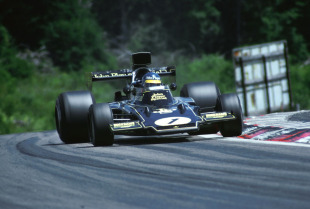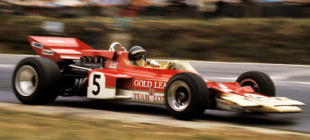
With 11 brand new Formula One cars expected to break cover over the next two months, it's hard to imagine a time when one of the sport's biggest names would run the same chassis for six seasons. Yet between 1970 and 1975 Lotus did just that, winning 20 races, two drivers' titles and three constructors' championships with the Type 72.
It is one of the most iconic Formula One cars of all time and its success and longevity in the sport are testament to its brilliant design. Among the most revolutionary cars to come out of Hethel's factory gates, some of the concepts behind the Colin Chapman- and Maurice Philippe-designed car were at least two years ahead of their time in 1970. Its side-mounted radiators and overhead airbox provided styling cues and engineering solutions that are still in use on modern F1 cars and its in-board brakes were just one example of Lotus's drive to reduce unsprung weight. After some initial teething problems it proved to be sensationally quick, and in the hands of some of the era's best drivers it won races in four of the six years it competed.
In all there were six specifications of the Lotus 72, but the fundamental design remained unchanged throughout. The original specification, however, was flawed and only lasted a single championship race before Chapman returned to the drawing board. The novel anti-dive and anti-squat suspension geometry, which attempted to eradicate the Lotus 49's tendency to pitch under braking and acceleration, made the car incredibly difficult to drive. Lead driver Jochen Rindt was not a fan and his initial scepticism towards the car was only enforced when he was lucky to escape a 175mph brake failure during the 72's first outing at the Spanish Grand Prix. In David Tremayne's biography of Rindt, Uncrowned King, privateer Rob Walker recalled the subsequent exchange between Rindt and Chapman in which the Austrian driver told his team boss: "I'll never sit in that f***ing car again as long as I live".
It was an underwhelming debut and the car was sent back to Hethel to have the suspension geometry completely overhauled, with the anti-squat and anti-dive innovations scrapped. For the next two rounds Rindt drove his trusty Lotus 49, with the 72 undergoing two spec changes before he would climb back in the cockpit for the Dutch Grand Prix. By then, however, the 72C was a dream to drive and Rindt began a four-race winning streak.
The four victories were enough to put him in a commanding position in the championship and he went to tenth round at Monza in the hope of sealing the championship. Once again Rindt asked for the Lotus 49, aware he only needed a few more solid points finishes, but Chapman turned up at the Italian Grand Prix with three 72Cs, effectively telling Rindt to like it or lump it.
A decision was taken to strip the 72C of its wings in order to reduce drag, but in doing so the car became incredibly twitchy. Rindt could live with it but his team-mate John Miles returned to the pits saying the car was undrivable during Friday practice. Lotus new recruit Emerson Fittipaldi, who had been given the job of shaking down a new chassis for Rindt on Friday, crashed after just a handful of laps on the approach to the Parabolica.

But Rindt was confident of a good result and on Saturday set off to try to get among the front two rows to ensure he was in a good position for Sunday's inevitable slipstreaming battle. However, after just five laps his car veered off the track at the Parabolica and its low-slung nose went under the guardrail before hitting a stanchion with immense force. Rindt suffered fatal injuries to his aorta as he slipped down in the cockpit and under his seatbelts.
A front-left broken brakeshaft was put forward as the cause of the accident, although it is not clear whether it broke on impact or before. Other theories point to the wingless set-up catching Rindt out under braking, but those close to the driver believe that was unlikely. He went on to become Formula One's only posthumous world champion.
Fittipaldi won another race towards the end of 1970, but 1971 proved to be a difficult year for Lotus and the 72. The team was distracted by failed attempts to make its turbine-engined, four-wheel-drive 56B competitive and the team didn't win a single championship race for the first time since 1960. At the Monaco Grand Prix the 72D specification was introduced and towards the end of the season Fittipaldi really started to click with the car.
In 1972 the strong form got stronger and the Brazilian won five races, taking the title by 16 points from Jackie Stewart. The cars also looked the part as it was the first year Lotus ran its distinctive John Player Special livery (the livery that provided the inspiration for the black and gold Lotus cars in Formula One today). However, there was an air of controversy around the car and its rather suspect rear wing.
Moveable aerodynamics had been made illegal in 1969, but in 1972 the 72D was fitted with a rubber bush on the rear wing's mount to allow it to change its angle at high speed. In the pits a mechanic or scrutineer was able to put all his weight on it without the wing moving, but under the high aerodynamic loads on a long straight the angle of the whole wing changed and reduced drag. The wing avoided detection until McLaren's Denny Hulme spotted Fittipaldi's helmet appearing above the wing on long straights. At the risk of being rumbled, Lotus removed the rubber bush and no further action was taken.
For 1973 the 72E was introduced with deformable crash structures around the fuel tank in order to meet new regulations. The 72 was now in its fourth year of competition, but was no longer running on the Firestone tyres for which it had been designed and the switch to Goodyears didn't do much to flatter the aging chassis. Despite a strong start to the season, with three wins and three podiums in the first six races, a gearbox failure at the Swedish Grand Prix triggered a four-race slump and Fittipaldi struggled to recover.

By that time the 72 was five years old and Lotus's rivals were starting to move the game on. Its replacement - the Lotus 76 - turned out to be a disaster and by Monaco Peterson was asking for his trusty 72 back, just as Rindt had done with the 49 back in 1970. Peterson went on to win the race and took two more gritty victories in France and Italy before the end of the year. However, it was clear that the 72 was outdated, and to make things worse Lotus was no longer receiving the latest specification Goodyear tyres.
Lotus had no other option than to stick with the 72 in 1975 and, unsurprisingly, the results were mediocre. Peterson's best finish was a fourth place at Monaco, and although Ickx scored a podium in Spain he left the team after the French Grand Prix. The car, which underwent one more modification to lengthen its wheelbase to become the 72F, scored points at its final race in the hands of Peterson before it was retired ahead of the 1976 season. In its place came the interim Lotus 77 before Chapman once again turned the rule book inside out with the Lotus 78 ... but that's another story.
Laurence Edmondson is deputy editor of ESPNF1
© ESPN Sports Media Ltd.
 Laurence Edmondson is deputy editor of ESPNF1 Laurence Edmondson grew up on a Sunday afternoon diet of Ayrton Senna and Nigel Mansell and first stepped in the paddock as a Bridgestone competition finalist in 2005. He worked for ITV-F1 after graduating from university and has been ESPNF1's deputy editor since 2010
Laurence Edmondson is deputy editor of ESPNF1 Laurence Edmondson grew up on a Sunday afternoon diet of Ayrton Senna and Nigel Mansell and first stepped in the paddock as a Bridgestone competition finalist in 2005. He worked for ITV-F1 after graduating from university and has been ESPNF1's deputy editor since 2010

